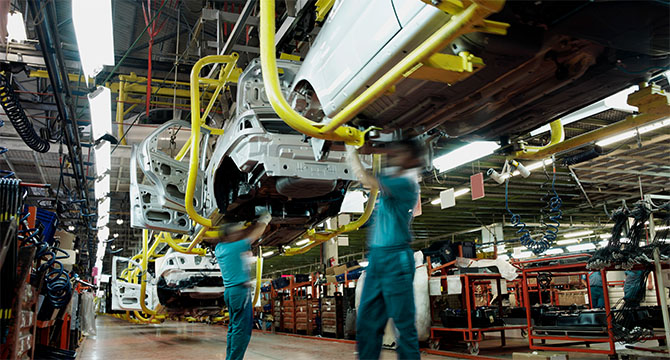Future of the Automotive Sector in Europe, China and the United States

Guest Author: Ruth Knox, Managing Associate, Linklaters LLP
Given the pace of change in the automotive industry and related technologies, combined with increasing regulatory scrutiny, what risks and challenges can the global automotive industry expect to deal with in 2018 and beyond across Europe, China, and the United States?
On April 10, 2018, Foley & Lardner and Linklaters LLP, a global law firm based in the U.K., held a roundtable on the “Future of the Automotive Sector in Europe, China and the United States.” Major points addressed at the roundtable are summarized below.
Major recent cartel claims in respect to automotive parts in Europe
Bernd Meyring, Partner at Linklaters highlighted the increasing scrutiny of the automotive sector by the European Commission in recent years with respect to: (i) potential cartel activities (after the historic Carglass case); and (ii) sector mergers. The discussion also centered on the risk that industry standardization of components, while achieving compliance with regulatory and technical standards, developing synergies and potentially bringing down costs, might run afoul of competition law. With European merger control scrutiny focusing on production facility locations and car models more than type and innovation capabilities, companies merging in this sector must consider antitrust law at an early stage. In addition to antitrust concerns, additional attention must be given to the national security reviews that many deals are becoming subject to, such as the Committee on Foreign Investment in the United States (CFIUS) review. It was observed that the costs of developing connected, autonomous and electric vehicles and components are putting enormous financial pressures on market members to the extent that consolidation in the sector is anticipated.
Key cooperation models emerging in tech M&A around the world
The discussion then progressed to recent developments in M&A, with Pierre Tourres, Partner from Linklaters in Paris, noting that the development of restrictions on foreign investment are coupled with a strong drive on the part of OEMs to invest in technology companies, some of which are in their infancy. Participants learned about the different pricing and structuring of incentives to retain start-up talent and how such start-ups must at the same time ensure proper protections of their IP rights and the inventions that such talent creates.
On data protection, Pauline Debré, Partner at Linklaters in Paris, commented that the EU General Data Protection Regulation will bring stronger sanctions that will be akin to competition law sanctions in scale. Attendees also learned that personal data generated in the EU and processed outside of the EU will be subject to the regulation, with those subject to the regime being required to prove compliance at any given moment.
Richard Gu, Partner from Linklaters in Shanghai, noted that the cybersecurity law implemented in China last year requires personal information and important data that is stored locally to be subject to an impact assessment if there is a need to export personal information and important data outside of China. Richard also commented that the valuation of technology companies in China is currently very high, with a strong government focus on developing this market, which is dominated by local players. CFIUS remains the biggest concern in China with respect to target companies with sizeable operations in the U.S.
Steve Hilfinger, Partner at Foley & Lardner LLP, gave the U.S. M&A perspective, noting that the strong M&A market in the automotive sector is continuing as the automotive market continues to outperform other markets on a relative basis. There are some headwinds, however, given how long the current positive cycle has lasted and the current rising interest rate environment, which will lower debt capacity and therefor purchase prices (all else being equal). He noted that the 2017 Tax Act has also provided a boost to disposition activity, given the ability to take accelerated depreciation on certain fixed assets. The tech sector continues to be a strong part of automotive M&A, with two transactions alone generating aggregate enterprise value of $23 billion (Mobil Eye and Harman). Participants also noted the recent Trump Administration decision to review certain environmental and fuel economy standards, and how that might impact the continuing imperative towards light weighting which will remain a commercial objective.
Licensing challenges related to standardized technologies for connected vehicles
Participants heard from Debré on standardization to enable interoperability of equipment, something that has been a hot topic in telecoms for many years and is now of key relevance to connected cars. Historically, the automotive sector has not experienced the same level of litigation as the telecom sector, but with technological development rising, a strong licensing strategy will be a key issue for market players. Standards can take years to develop and are achieved when industry players choose one technology over another, after which those that hold the patents over the relevant technology must commit to license to any willing licensee on fair, reasonable and non-discriminatory terms (FRAND or RAND in the U.S.). Pauline delivered insights on how litigation has progressed in this area recently.
The discussion highlighted the risk of an entity abusing its dominant position and the risk of a licensee using contract law to challenge a Standard Essential Patent (SEP) owner to license a technology. Pauline noted the right of SEP owners to obtain an injunction in European courts, something that is not generally available in the U.S and is a powerful enforcement tool. She also touched on the basis for calculating royalties, which can be paid as a percentage or a lump sum. The trend has been for those seeking to implement the standard to prioritize the SEP owners that hold the biggest portfolio in terms of patents. Legal and technical assessments need to be made to review what the standards are, which patents are captured and who the owners are. Because all indications point to a new wave of patent litigation pending, sector members should take a close look at their litigation and licensing strategy.
Development of law and policies on electric and autonomous vehicles across the globe
Nick Englund, Special Counsel at Foley & Lardner LLP and formerly with the National Highway Traffic Safety Administration (NHTSA), provided key insights on the development of the law governing autonomous vehicles in the U.S., briefing the audience on the role of NHTSA’s Federal Motor Vehicle Safety Standards and its authority over safety-related defects. He also expounded on the U.S. Department of Transportation and NHTSA’s Automated Driving Systems: a Vision for Safety (ADS 2.0). ADS 2.0 emphasizes the importance of (among other things) developing and maintaining a robust product safety validation process (with simulations coupled with testing on tracks and public roads), defining the operational design domain of the vehicle, designing fallback conditions in case of malfunctions, protecting cybersecurity, and educating users of the appropriate uses and limitations of the highly autonomous vehicles (vehicles rated on the SAE automation levels 3 through 5). He also spoke about the pending legislation in the U.S. – the SELF DRIVE Act that passed the U.S. House in September 2017 and the proposed AV START Act in the U.S. Senate. Among the issues addressed in each bill, both would create additional exemptions to safety standards for highly autonomous vehicles; preempt state laws related to design, construction, and performance; and address cybersecurity and data privacy concerns.
Ruth Knox, Managing Associate, at Linklaters, delivered an overview of developments on AVs across Europe, including several policy and legislative instruments that effectively extend the pre-existing liability rules to incidents involving driverless vehicles. Legislative and policy activity has progressed more at the national level than at the EU level and there is consensus that, in due course, the regime will move to a product-liability-based regime that may be unified across the EU. With the increasing importance of incident-data recorded in the vehicle’s black box, component manufacturers need to think about their insurance coverage in a world where court rooms become more proficient in tracing the computer evidence of the operative causes of traffic incidents.
Richard Gu confirmed that the regulatory position on liability for AV incidents is unchanged in China, with several regions enabling testing of AVs. He also highlighted the importance of EV roll-out in China, providing an overview of the credit system that incentivizes production of these vehicles.
Whether U.S. liability law for autonomous vehicles will follow the European and China models, or take a different path, remains to be seen.

